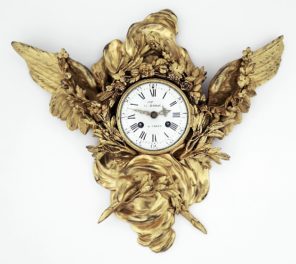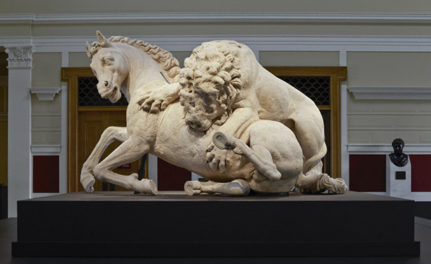
Senior designer Amanda Ramirez affixes a label below a vitrine holding bronze statuettes in the Getty Villa’s Etruscan gallery.
As an exhibition designer, I have the privilege of working closely with objects, to learn by looking at them from all angles, in just the right light. Seeing them from different viewpoints often reveals why they are so special—whether it’s clues from the artist’s hand, marks of wear from its ancient function, or a smile-coaxing beauty. My challenge and goal is to extend this privilege to museum visitors.
When approaching the redesign of the galleries and reinstallation of the antiquities collection at the Getty Villa, the design team focused on supporting connoisseurship—the skill set of close looking and visual discernment—in the galleries. Enabling meaningful encounters with the objects requires presenting each artwork at its best. More importantly, we wanted to offer visitors opportunities to make their own discoveries—to see for themselves what artworks stand out for their formal mastery or exquisite craftsmanship.
Along with the curatorial reorganization of the galleries by culture and chronology, this guiding principle is carried through the Getty Villa in three main ways.
Can We Be Closer?
The first way to privilege the visitor’s view of objects is to reduce spatial and physical barriers.
With visitor and object safety being our priorities, for each artwork we questioned the use of railings, glazing, or furniture, which can create distance or a disconnect between the viewer and objects. We sought a careful balance that offers unique chances to be nose to nose with a bronze or unbothered by glare when viewing unglazed wall-sized fresco fragments. The increased visibility of the objects invites visitors to make observations in a more visceral way.

Left: Unglazed fresco murals adorn the gallery walls, as they would have in an ancient villa. Right: A bronze statue is displayed in the round without a vitrine.
Where objects are still enclosed in traditional casework, we made every effort to reduce the distance between it and the viewer. Almost every new case built for the reinstallation is shallower than those previously used. Visitors can now get closer to the art, and designs with fewer objects layered one in front of the other result in a cleaner view.
Coins and gems are typically placed just millimeters behind the glass and angled meticulously to catch raking light. A visitor can see such pieces no better than if they were laying in their own hand.
Many objects are viewable in the round, allowing unfettered access. Likewise, fewer cases depend on built-in lighting; the transparent tops contribute to the feeling of openness in the galleries. In instances where the object is very small or it was impossible to show multiple viewpoints (like the back of a carved gem), we deployed digital viewers to enhance the limits of vision.

Left: A shallow shadowbox with a digital viewer at lower right allows close viewing of jewelry. Right: A slender freestanding vitrine provides visual access to bronze statuettes from all angles.
Can We Be Quieter?
A visit to the Villa is a sensory carnival, as layered gardens, grand columns, and sumptuous finishes inspired by the ancient Villa dei Papiri continue into the gallery interiors. There is no shortage of beautiful details to capture your attention. Yet our objective is to make the art the focal point of the interior spaces. In service of this mission, the exhibition components are minimalist in comparison to the architecture, creating a distraction-free frame for experiencing the objects.
Simplified exhibition furniture also creates an important separation between the replica architecture and the antique collections. For instance, we limited the use of historicizing brass details, shaped furniture legs, and sculptural light fixtures that were a part of the existing design language. Those details that remain, like the brass bezels around the glass, provide an important bridge to the architecture.

Left: The material splendor of the Villa is evident in the Atrium’s multicolored coffered ceiling, paneled walls, and patterned mosaic floor. Right: The relatively simplified coffered ceiling and monochromatic terrazzo floor of the new Greek Vases gallery (103).
In addition to slimmer furniture designs, we streamlined casework profiles by adjusting the moldings and reducing tiers. Plinths, risers, wedges, and other furniture components used inside display cases were reduced in quantity and visual volume, which increases the presence of the objects.
The design scheme limits case interior colors to three values of cool gray. While not overly scientific in feeling, the grays provide an objective, documentarian-like quality to the backgrounds. The principal gallery wall colors are a related series of grays and gray-blues.
Smaller galleries throughout the museum are punctuated by a high-chroma red often associated with Pompeian murals, deep watery blue, gold, and dark olive. These galleries are typically thematic in terms of collection content or scope of interpretation, so the colors provide a visual signifier of the shift from the adjacent galleries, as well as contribute to pacing and visual variety in the museum.

Left: A preparatory study shows the process for determining the gallery wall color palette and finishes. Right: The new monochromatic gallery introduction text panels feature a standard design for cartographic and timeline information.
The visually quiet approach to design also encompassed the interpretive graphics, which are nearly monochromatic and cleanly gridded, with content structured systemically so visitors can find similar information in parallel formats from one gallery to the next. When logical, object labels are placed on nearby walls, rather than on the exhibit furniture, to further clear the view of the art.
Can We Have More? Should We Have Less?
No one who works at a museum wishes for quality collections to be hidden from visitors in a storeroom. Access to art is a paramount issue to the public and our active community of scholars.
To display more art within a finite amount of gallery space is a quintessential museum struggle, so during design development we had ongoing discussions about density to ensure optimal environments for delivering an ideal visitor experience. Museum staff prepared the maximum number of objects and cases for deployment. Then, during gallery installation, there were further adjustments to improve sightlines and address overcrowding.
The reinstallation created about 3,000 square feet of new gallery space within the existing envelope of the Villa. The smallest annex—Gallery 216, the Roman Treasury—was designed to provide maximum flexibility for the presentation of a large quantity of small precious objects.
Two built-in cases form the backbone of the gallery; they were inserted with surgical precision against and between the building’s structure and detailed to preserve every possible centimeter of display depth for the artworks. A precious metal and stone collection is now on view, but the cases could be collapsed for the exhibition of coins or jewelry in the future.

Left: The flexible built-in case designed for the new Roman Treasury (Gallery 216) features a dense presentation of objects in a small space. Right: A single object with a strong graphic presence populates the small Gallery 101F.
While unconventionally small galleries pose added challenges for both space planning and lighting, the replica Villa architecture gives most galleries a familiar domestic scale, which is an asset in delivering up-close, personal encounters with art. The scale creates intimacy, urging you closer or slowing you down long enough to see a new detail.
As visitors meander between galleries that are dense or, for contrast, concise in their presentation, the prompts for how to interact or look at the art shift. For example, some galleries offer opportunities for discovery by exercising visual comparison, while others invite visual attention and focus.
We hope visitors experience, through improved visual access and organization, an enhanced connection to the art. The reinstalled galleries present the collection as scholars would study it—allowing everyone the opportunity to discern for themselves what aesthetically exceptional artworks catch their eye. To put it simply, our goal was to share the view.




Excellent job Amanda & team. We can’t wait to visit again and see all the incredible changes!
Congratulations Amanda to you and the Villa team for this incredible accomplishment. The site looks beautiful!
Thanks, Amanda, for your Iris blog article. Now I know why the reinstallation is so much more intimate than before. I feel closer to each work of art, it’s almost like being next to the artist as the work is finished.
The villa is a personal favorite due to the care taken to intertwine the antiquities with architecture and environment. An incredible collection is easily accessible from the visual and the intellectual. The villa gallery interiors are pleasantly attuned to the art and enhance the architectural elements of metals and stone. Beautifully done.